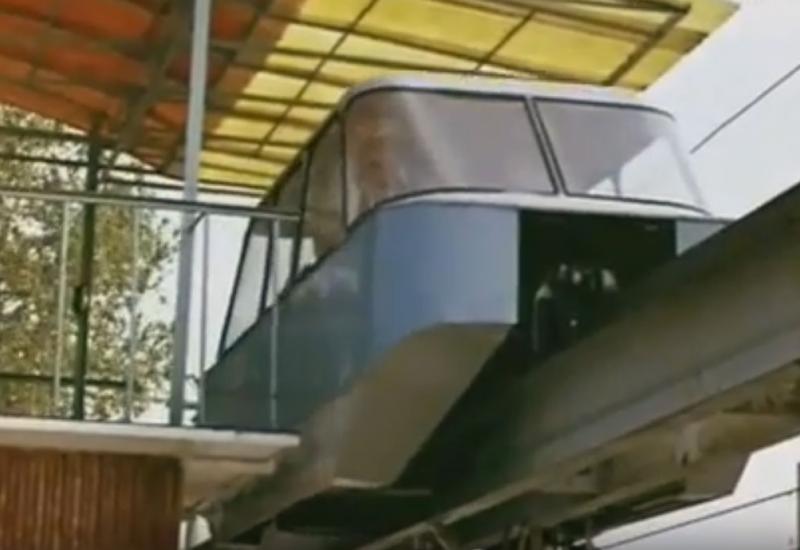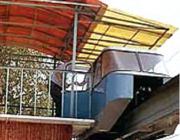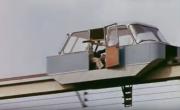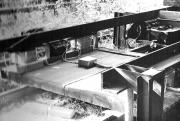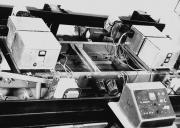The history of Kyiv Polytechnic preserves many facts about scientific developments that began in Igor Sikorsky Kyiv Polytechnic Institute, seemed very progressive, but for various reasons did not find further development in Ukraine. In particular, the monorail road with a linear electric drive was developed in the 1960s and 1970s at the Department of Automation of electromechanical systems and electrical drives (AEMS-ED) with the participation of the Department of Electric Machines at the Faculty of Electrical Engineering (now FEA). For half a century, those studies of the monorail overpass transport system have become overgrown with legends and retellings. Let's mention some of them.
They were the first
It is said that the history of domestic monorail transport with a linear induction motor began with the May Day demonstration. A group of employees of the Igor Sikorsky Kyiv Polytechnic Institute made the model of a car with a linear motor for a festive demonstration stand with a capacity of only 15 watts. Igor Sikorsky Kyiv Polytechnic Institute scientists (O. Shapovalenko, K. Bykov, A. Vyshkinin, head S. Rebrov) together with the Kyiv Electric Transport Plant (director G. Izhel) began to develop and research electric drives with linear motors in 1963. A car for 6 passengers and 1 driver with two hauling linear engines with a capacity of 5 kW was created in 1966. This allowed to receive funds from the Government of Ukraine for the construction of a 525 m long ring road for the Exhibition of Economic Achievements (VDNG) of Ukraine in Kyiv. The development promised to reach large urban and interurban spaces later.
Searches and finds
In the initial designs, the stator of the linear motor was rigidly attached to the car of the monorail and the gap between it and the rotor (jet line) had to be made large so that during lateral oscillations of the car and on turns they do not touch each other. The engine was heavy and energy intensive. Scientists have found a simple but successful solution: the stator began to lean on the rotor through the rubber wheels and follow it, while the traction force was transmitted to the body through a flexible connection. The cars could move on a light overpass of rolled steel at speeds up to 52 km / h.
At the same time, electric drives with linear motors for ingot truck (24 kW, 36 km / h) and towball of the experimental pool of the Institute of Hydromechanics of the Academy of Sciences of Ukraine were developed and implemented.
Plans, plans
In 1966 National Research Institute Promtransproekt has developed for Kyiv a project of a hinged monorail route from the metro station "Hydropark" to the 1.8 km long Paton Bridge. It was developed to house two stations. The road was to run at a height of 6-11 m. A car weighing 20 tons, designed for 120 passengers, was to run on the road. Traction engines with a capacity of 160 kW were to provide a maximum speed of 120 km / h. Much attention was paid to traffic safety. Devices for power supply, communication, signaling, centralization and blocking of the catenate were to provide automatic speed limitation on curved sections, counter clockwise turns and when approaching the station. At stations, the car had to stop regardless of the driver's mistakes.
In 1970, the 3.5 km long Bereznyaky - Hydropark line was designed. They were very interested in the initiative in Kazakhstan, as the subway could not be built there, they planned a new exotic mode of transport. But work on the projects was soon stopped.
Demonstration at the VDNG, landfill on the Kiev Sea
The efforts of polytechnics were not in vain. The monorail road was built in 1967 on the territory of the VDNG in Golosievo. It is considered to be the first monorail route in the world with a linear electric drive (for example, the Transrapid-01 transport system with a linear motor and magnetic suspension began to be built in Germany in 1969).
The demonstration monorail road at the VDNG existed until 1972 and was dismantled during the construction of the pavilion of consumer goods. In 1971, a delegation from the Ministry of Transport of the Federal Republic of Germany came to see the Kyiv attraction. In 1970, the road was filmed in the TV film "The Funny Adventures of Tarapunka and Shtepsel", thanks to which we can see what the development of Kyiv Polytechnics looked like in action (photo 1).
The turbulent sixties were a time of progress and hope for a better future. Numerous exhibits of the VDNG inspired the audience to creative work. Enthusiasts dreamed that soon it will be possible to run on a monorail (photo 2).
For further research, a landfill was set aside on the left bank of the Kyiv Sea, not far from the village of Lebedivka. At the landfill a full-size subway car with a linear asynchronous electric drive has already been used as an experimental vehicle.
However, monorail transport has not become more widespread in Kyiv. This is due to the shortcomings of linear electric motors, which for technical reasons have a significant amount of operating air gaps, which leads to additional losses and significantly impairs the weight-size parameters and energy performance of the machine. Climatic and weather conditions in our region did not contribute to development.
Magnetic flight
An important problem in the creation of transport systems with a linear electric drive was to ensure contactless adjustment of the position of the transport crew based on the use of magnetic suspension, which provides its levitation and allows to increase the speed to 350-500 km / h.
In the mid-70's and 80's, FEA's Department of Electric Drive took an active part in the All-Union program to develop a system of high-speed land transport with linear electric drive and magnetic suspension (O. Shapovalenko, V. Gavrilyuk, V. Teryaev, O. Redko, Head of the Department M. Popovych). At that time in the yard of the main building there was a section of the transport structure 50 m long with a working model weighing 400 kg, which was held on a magnetic suspension (photo 3).
Another group of scientists who worked at Igor Sikorsky Kyiv Polytechnic Institute at the same time (headed by L. Piven) tried to make a magnetic suspension based on the pole shift forces of unregulated electromagnets. But it was stable only vertically, and all attempts to obtain a neutral state horizontally by optimizing the geometry of the poles did not work.
The model of the transport crew with the largest weight - 2500 kg, which was fully held on an adjustable electromagnetic suspension both vertically and horizontally, for the first time in the USSR, was created in Igor Sikorsky Kyiv Polytechnic Institute in 1981 at the Department of Electric Drives (now - AEMS-ED) in the laboratory of FEA's building №20 (photo 4). According to the results of this work, the dissertation of the candidate of technical sciences V.I. Teryaev was defended
Current state
Currently, monorail transport has established itself in several niches - as entertainment (in parks, zoos, recreation areas, at exhibitions), as automatic transport at airports for communication between terminals and transportation to public transport, as well as urban and interurban passenger transport . Due to the quietness and lack of vibration, monorail transport can pass through residential areas and even through houses in densely populated cities.
Inter-city high-speed land transport with linear electric drive in combination with magnetic suspension provides the possibility of contactless movement and is a worthy competition to air, road and rail transport, especially in terms of safety, environmental friendliness, quietness, ability to deliver passengers and cargo directly to other destinations without transfers to other means of transport. Such transport systems are widely used in Japan, China, Germany, USA, Canada.
The priority still remains for the Igor Sikorsky Kyiv Polytechnic Institute, but, unfortunately, only a priority…
Despite financial constraints and technical difficulties, work in the field of magnetic suspension systems and linear electric drive in Igor Sikorsky Kyiv Polytechnic Institute continues at the Department of AEMS-ED of FEA. Thus, in recent years, 6 master's theses were defended on the topic of linear electric drive and magnetic suspension, including ones with a demonstration of the current system of electromagnetic suspension with active vibration protection, 5 scientific articles and a section in the textbook were published, in 2017 2 patents of Ukraine for systems of adjustable electromagnetic suspension were received.
The issue of free gilding in space (levitation) has interested people for a long time. The use of different magnetic suspension systems provides this possibility, but it is a topic for separate consideration.

